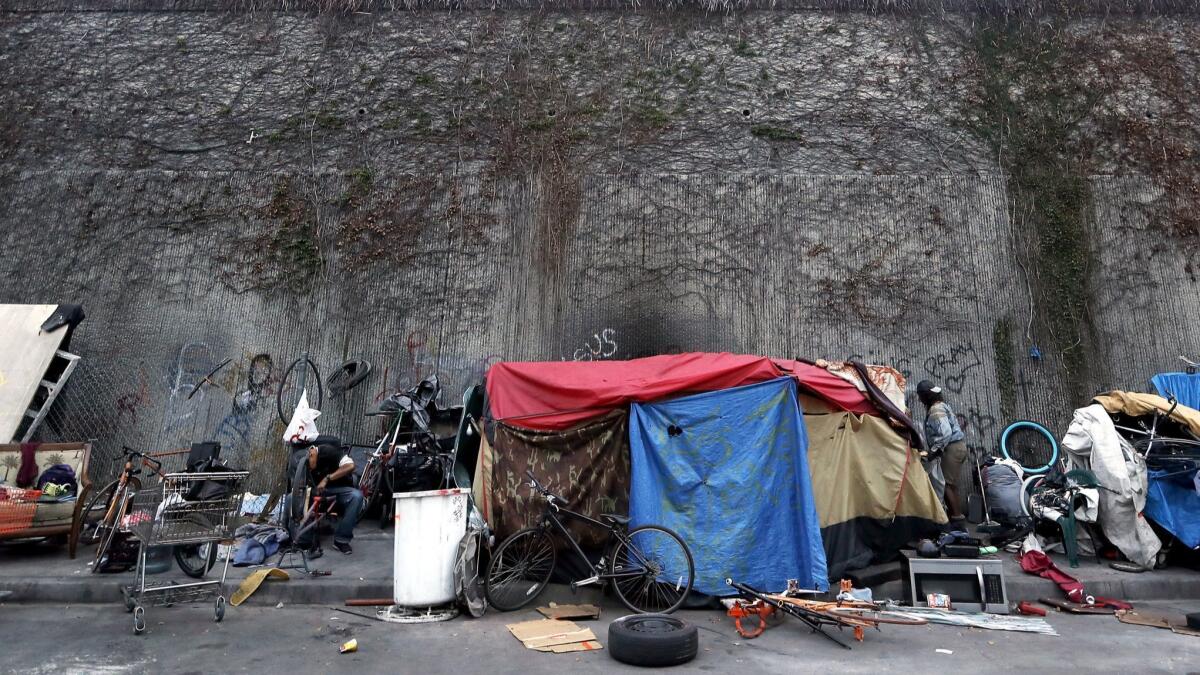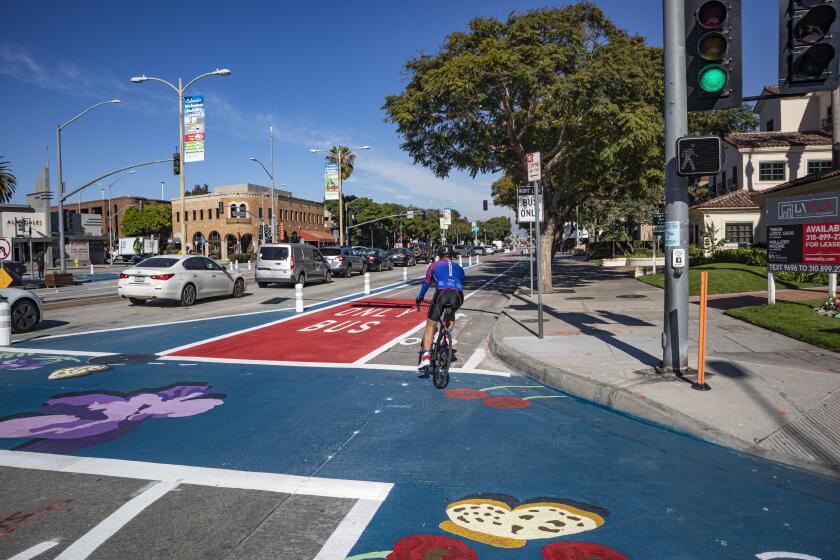Editorial: Want to get homeless people’s dirty belongings off the sidewalks? Put them in apartments

- Share via
As homeless encampments have sprawled across sidewalks throughout the city of Los Angeles, officials have struggled to balance the needs of the people who live in them with the needs of the other city residents who walk past them, work around them and live nearby, and who are alternately annoyed and discomfited by their presence.
The city has yet to get that balance right. In March of 2016, the City Council set new rules specifying (to the gallon) the amount of personal property homeless people can carry with them and setting guidelines for the confiscation and storage of any excess by city workers. At the same time, the city was slapped with a lawsuit alleging that sanitation workers had thuggishly snatched homeless people’s possessions and destroyed them during arrests and cleanups. As a result, a court put the city under an injunction limiting the confiscation of belongings in the skid row area of downtown. The case is pending, and downtown business groups contend that the injunction has discouraged any enforcement at all, leaving sidewalks choked with the tents and other belongings of homeless people.
In another attempt to clean up sidewalks, Mayor Eric Garcetti and the council rolled out a program to place new, city-run “bridge shelters” in areas with concentrated homeless populations. The mayor vowed that if neighborhoods embraced the shelters, which would take in homeless people from the surrounding streets, he would step up sanitation services and the enforcement of ordinances against lingering on sidewalks during the day and amassing excessive property in those particular neighborhoods. Shortly after the city announced the start of this effort in the Olvera Street area around the new El Pueblo shelter, the Legal Aid Foundation of Los Angeles sent Garcetti a letter warning that such enforcement could result in violations of homeless people’s constitutional rights.
Homelessness won’t be solved by pushing people from street corner to street corner or by taking away their shopping carts.
This seesaw between protecting the rights of homeless people and trying to address the broader needs of all city residents will continue as long as there are thousands of homeless people living on the streets. Rather than engaging in an endless series of battles in court with homeless people and their advocates, the mayor and council should work out plans with those advocates for making the sidewalks cleaner and functional while not infringing on homeless people’s rights. That’s just what the Legal Aid lawyers asked for in their letter to the mayor.
Of course, the city should not give up on trying to keep the streets clean, safe and usable, and especially to address issues that affect public health. (See the recent article in the Los Angeles Times about the spread of typhus among the homeless.) Toward that goal, there are some basic things the city should be doing right now. It should provide more toilets and shower facilities in areas with large concentrations of homeless people (such as skid row). And it should have sanitation workers provide trash cans on streets with homeless encampments and schedule pickups. It also needs to provide more storage facilities for peoples’ belongings.
If the city is going to stick with its 60-gallon limit on belongings, or if it is going to more aggressively enforce its existing ban on sitting and sleeping on the sidewalks during the day, officials must remember — and so should we all — that the ultimate solution, the only real long-term solution, to this crisis lies in getting more people housed faster. Homelessness won’t be solved by pushing people from street corner to street corner or by taking away their shopping carts.
Enter the Fray: First takes on the news of the minute from L.A. Times Opinion »
As of now, not one room of housing funded by Proposition HHH, the $1.2-billion bond measure city voters approved two years ago to provide permanent supportive housing for homeless people, has opened. Nor will any open this year. Almost 2,100 units of supportive housing have been approved; a few hundred of these are in construction, the rest are still in preliminary stages. Some will open next year. But most won’t open until 2020 or 2021.
It’s difficult to speed up the completion of low-income and homeless housing development projects. The city pays for only a portion of the project. Rounding up the rest of the funding sources often takes more than a year. That’s before construction, which takes an additional year or two, even starts.
Given that timeline, the mayor and the City Council need to push for more innovative approaches to building this housing. That could mean using prefabricated units, building shared housing (which would get more people off the street faster) or finding speedier ways to secure financing. Miguel Santana, the former city official who now chairs the citizens’ committee overseeing HHH funding, is working on a new set of guidelines for developers who want to take different, faster approaches to financing and building. Progress on that front is crucial if the city is going to make headway anytime soon on its homelessness crisis.
Follow the Opinion section on Twitter @latimesopinion or Facebook.
More to Read
A cure for the common opinion
Get thought-provoking perspectives with our weekly newsletter.
You may occasionally receive promotional content from the Los Angeles Times.






